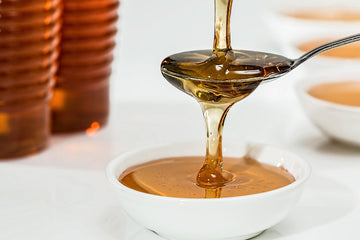Honey - Is it healthy or fattening? What about Honey roasted nuts?
by Jes @SnackFirst on May 10, 2022

What is honey?
Honey is man's first sweetener. Honey bees date back to millions of year before, way before the appearance of man. Over 10,000 years ago, humans first encountered nectar and decided to taste them. Honey was historically used as currency and as medicine in the 19th century. It can be used to treat burns and applied tropically on wounds. Needless to say, this 'nectar of god' was highly sought after before the invention of cane sugar.

Honey is a natural secretions from plants and is made by bees. These bees store honey in honeycomb wax structures and its main sweetness come from fructose and glucose. They have the same sweetness as sugar but sugar are commercially made and made of sucrose. Honey has a very low moisture content and is acdic, making them unsuitable for bacteria to grow. Thus, sealed honey does not spoil even after thousands of years.
Honey- Is it healthy?
Honey is actually considered a superfood. Some benefits include anti bacterial properties to boost your immunity and prevent illnesses. There are antioxidants content which can reduce the risk of cancer and heart diseases.
Honey is also a soothing remedy. For cold and flu illnesses and even sore throat, honey, or with addition of lemon, is widely used to sooth cough and reduce phlegm production. As a natural cough suppressant, this sweet drink is popular among kids and tasty to be taken daily. Honey is widely used and proven to be effective for upper respiratory tract infections (URTI) and more so now, with the spread of COVID and other viruses. 
Raw honey vs Pasteurized
Raw honey is honey in its most natural form, straight from the beehive. Similar to our raw nuts, raw honey will have the most nutrition as they are not heat processed. More nutrients and antioxidants will also be found with this extraction but they are more murky or cloudy, and not suitable for babies before 1 year old due to the amount of bacteria that might be inside.
Pasteurized honey has been heated to 160 degrees celsius to kill any yeast that might be found. It is also filtered so there is less contamination and taste smoother. Beware of those commercial honey that may add corn syrup into honey to make them less viscous. These are not as healthy but are great to be added to food.
Colour of honey
The colour ranges from colourless to dark brown. The most common is light brown, but it all depends on the season and the floral source. Generally speaking, the darker the colour, the stronger the honey taste.

Some common types of honey
Eucalyptus: With a slight minty, medicinal taste, eucalyptus is distinctive and strong. As it tastes like menthol, it is great to treat stuff nose and reduce mucus production.
Buckwheat: This buckwheat honey has been found to be most effective in soothing our throat and suppress cough. As it is very viscous, it is claimed the the anti bacteria activity is higher than that of manuka honey.
Manuka: Manuka honey is distinctive in its anti bacterial properties with the chemical called methylglyoxal (MGO) from Manuka flowers. The greater the Unique Manuka Factor (UMF) number, it means the concentration of MGO is higher and the antibacterial effect is stronger. Compared to normal raw honey, manuka honey is darker and stronger in medicinal taste. Studies are inconclusive on whether a higher UMF or even Manuka honey, is better than raw or normal honey.

Tips to store and drink honey
Honey should be stored in the pantry, there is no need for refrigeration. Cool temperatures will actually make them thicker, or causes crystallisation. They can still be consumed after crystallisation, just that you might need to warm it up to make them flowable again.
The easiest way to take 1 tablespoon (20g) of honey is to mix it with ambient or lukewarm (45C) water. Ideally it is with an empty stomach for maximum absorption and to improve digestive system. It is widely known not to use metal spoon to scoop the honey as the metallic nature might 'kill' the antioxidants properties or reduce the healing properties. However, this is not true as the spoon is used only for 2 seconds and not for leaving it inside for long. Do take note not to use more than 60C water on honey as it might be toxic.
Honey - Is it fattening?
Now we are convinced of the superfood status of honey. But then it is still fattening right?
Ketogenic diet does not allow for honey but paleo diet includes raw honey or any natural source of sweetener. In general, honey contains around 8.6g of carbohydrates per 20g serving. With that being said, the daily limit for honey is around 20g (3 teaspoon or 1 tablespoon) only. Excessive consumption will definitely lead to weight gain and heart problems, similar to excessive intake of sugar.
So in short, yes they are healthy, but yes they also contain carbohydrates. It all comes down to the amount you take, versus your daily output.
Honey Roasted Nuts
Before the 1980s, nuts were glazed (added honey) before they are being roasted, resulting in a sticky, Only in 1987, honey roasted nuts were invented in USA. Food scientist Bill Hoover first roasted the nuts, then between 160 and 350 degrees, coated them with the honey, sugar or syrup. This helps to retain the sweet flavour longer and less sticky.
Are Honey Roasted Nuts healthy?
Honey roasted nuts do indeed contain more sugar and carbohydrates than the usual raw, unprocessed nuts. However, not everyone likes raw nuts and the taste are not as popular as flavoured nuts. Honey roasted nuts still contain the nuts' nutrition and can be taken occasionally. They are not as healthy but it's far better than potato chips! For kids who do not like nuts, honey roasted ones might be more palatable. We do have Honey Cashew, Honey Almonds, Honey Pecans, Honey Peanuts, Honey Macadamia and even Honey Walnuts.








